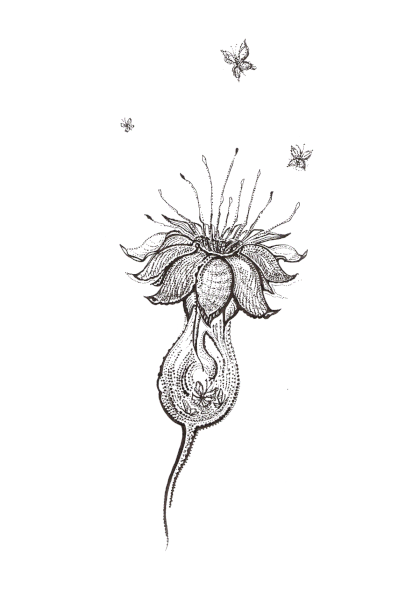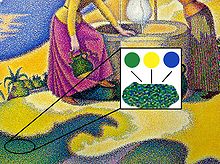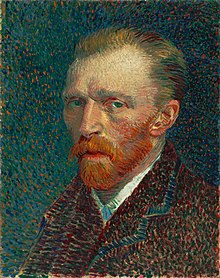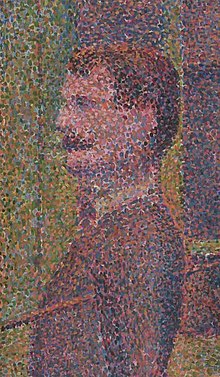Art
In a drawing or painting, the dots are made of pigment of a single colour, applied with a pen or brush; the denser the dots, the darker the apparent shade—or lighter, if the pigment is lighter than the surface. This is similar to—but distinct from—pointillism, which uses dots of different colours to simulate blended colours.[1]In printmaking, dots may be carved out of a surface to which ink will be applied, to produce either a greater or lesser density of ink depending on the printing technique. In engraving, the technique was invented by Giulio Campagnola in about 1510. Stippling may also be used in engraving or sculpting an object even when there is no ink or paint involved, either to change the texture of the object, or to produce the appearance of light or dark shading depending on the reflective properties of the surface: for instance, stipple engraving on glass produces areas that appear brighter than the surrounding glass.
The technique became popular as a means of producing shaded line art illustrations for publication, because drawings created this way could be reproduced in simple black ink. The other common method is hatching, which uses lines instead of dots. Stippling has traditionally been favoured over hatching in biological and medical illustration, since it is less likely than hatching to interfere visually with the structures being illustrated (the lines used in hatching can be mistaken for actual contours), and also since it allows the artist to vary the density of shading more subtly to depict curved or irregular surfaces.
Images produced by halftoning or dithering and computer printers operate on similar principles (varying the size and/or spacing of dots on paper), but do so via photographic or digital processes rather than manually. These newer techniques have made it possible to convert continuous-tone images into patterns suitable for printing, but artists may still choose stippling for its simplicity and handmade appearance. The Wall Street Journal still features stippled and hatched portraits known as hedcuts in its pages, a holdover from its earlier avoidance of photographs.
| Description | English: Carnivorous flower using stippling technique |
|---|---|
| Date | 14 October 2008 |
| Source | Own work |
| Author | Lidia24 |

http://en.wikipedia.org/wiki/Stippling
Pointillism is a technique of painting in which small, distinct dots of pure color are applied in patterns to form an image. Georges Seurat developed the technique in 1886, branching from Impressionism. The term Pointillism was first coined by art critics in the late 1880s to ridicule the works of these artists, and is now used without its earlier mocking connotation.[1]
Technique
The technique relies on the ability of the eye and mind of the viewer to mix the color spots into a fuller range of tones. It is related to Divisionism, a more technical variant of the method. Divisionism is concerned with color theory, whereas pointillism is more focused on the specific style of brushwork used to apply the paint.[1] It is a technique with few serious practitioners today, and is notably seen in the works of Seurat, Signac and Cross. However, see also Andy Warhol‘s early works, and pop art.
Paul Signac, Femmes au Puits, 1892, showing a detail with constituent colours.
Neuroplasticity is a key element of observing any pointillistic image. While two individuals would observe the same photons reflecting from a photo-realistic image, someone whose mind has been primed with the theory of pointillism will perceive the image differently as it is interpreted in the visual cortex.[2]
Practice
If red, blue, and green light (the additive primaries) are mixed, the result is something close to white light (see Prism (optics)). Painting is inherently subtractive), but pointillist colours often seem brighter than typical mixed subtractive colors. This may be partly because subtractive mixing of the pigments is avoided, and partly because some of the white canvas may be showing between the applied dots.The painting technique used for pointillist color mixing is at the expense of the traditional brushwork used to delineate texture.
The majority of pointillism is done in oil paints. Anything may be used in its place, but oils are preferred for their thickness and tendency not to run or bleed
Notable artists

Vincent van Gogh, Self Portrait, 1887, using pointillist technique.
- Georges-Pierre Seurat
- Paul Signac
- Henri-Edmond Cross
- John Roy
- Maximilien Luce
- Vincent van Gogh
- Camille Pissarro
- Théo van Rysselberghe
- Chuck Close
- Georges Lemmen
Notable Paintings
- A Sunday Afternoon on the Island of La Grande Jatte by Georges Seurat
- Bathing at Asnieres by Georges Seurat
- The Windmills at Overschie by Paul Signac
- Banks of Seine by Georges Seurat
- Une baignade, Asnières by Georges Seurat
- A Coastal Scene by Theo Van Rysselberghe
- Family in the Orchard by Theo Van Rysselberghe
- Countryside at Noon by Theo Van Rysselberghe
- Afternoon at Pardigon by Henri-Edmond Cross
- Rio San Trovaso, Venice by Henri-Edmond Cross
- The Seine in front of the Trocadero by Henri-Edmond Cross
- The Pine Tree at St. Tropez by Paul Signac
- Against the Enamel of Background Rhythmic with Beats and Angels by Paul Signac
- The Yellow Sail, Venice by Paul Signac
- Notre Dame Cathedral by Maximilien Luce
- Le Pont De Pierre, Rouen by Charles Angrand
- The Beach at Heist by Georges Lemmen
- Aline Marechal by Georges Lemmen
-
 Detail from Seurat’s La Parade de Cirque (1889), showing the contrasting dots of paint used in pointillism.
Detail from Seurat’s La Parade de Cirque (1889), showing the contrasting dots of paint used in pointillism. - Georges Lemmen
- http://en.wikipedia.org/wiki/Pointillism#cite_note-2Vase of Flowers by
No comments:
Post a Comment